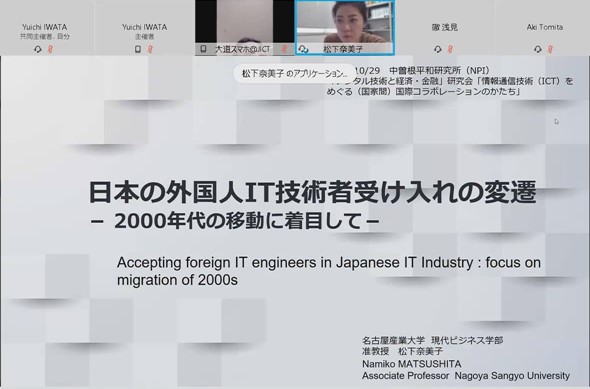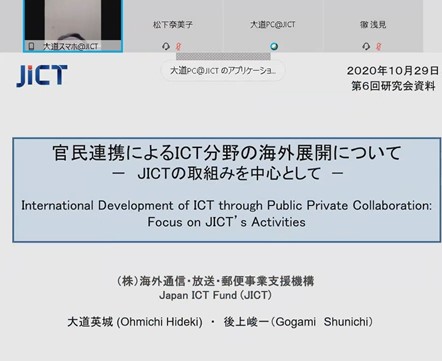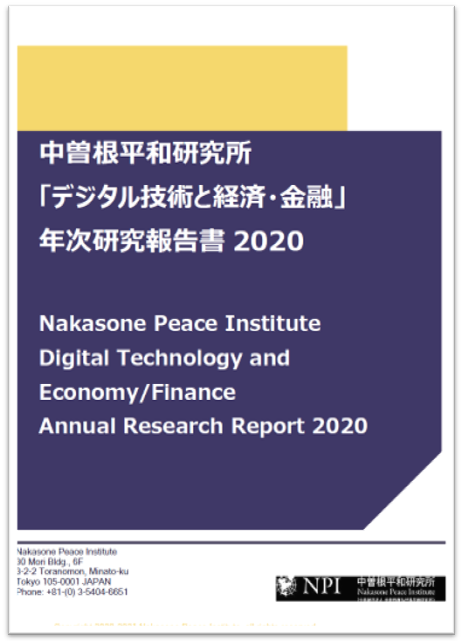2020/11/16
"The shapes of international collaboration in ICT " ("Digital Technology and Economy/Finance" Study Group)
The Nakasone Peace Institute held the web conference on "Challenges in Technological Innovation with respect to International Cooperation and Collaboration" with Dr. Namiko Matsushita (Associate Professor, Nagoya Sangyo University) , Mr. Hideki Ohmichi (Executive Vice President, Japan ICT Fund), and other regular members, on October 29th 2020.
1 Presentation "Accepting foreign IT engineers in Japanese IT Industry : focus on migration of 2000s" (Dr. Matsushita)
■Japan's past 30 years of accepting foreign IT engineers
When considering the possibility of future international cooperation in the field of ICT in the era of digitalization, it is important to look back on past international human resource exchanges.
One of the main reasons for the increase in the number of foreign ICT engineers in Japan was the revision of the Immigration Law in 1989. In the 1990s, most of the engineers were from North America, but in the 2000s, there was a shift in the number of foreign engineers from Asia. The global financial crisis of 2008-09 triggered an overall decline in the number of people coming from overseas, but since then the number of foreign professionals has been on the rise again.
■Looking back on the acceptance of high-level IT personnel from Asia in the early 2000s
Especially in the first five years of the early 2000's, there was a lot of effort to promote the acceptance of foreign personnel in the ICT field in Japan. This was due to the existence of the Japanese government's Basic IT Strategy, which included the early realization of e-government and the spread of e-commerce in conjunction with the broader use of the Internet.
At that time, the focus of cross-border exchange was mainly on Asia, with measures such as "standardization of IT skills (mutual certification of qualification systems and common standardized tests). In addition to the aforementioned policy factors, the relative disparity in wages and the rising unemployment rate in South Korea encouraged this movement. Furthermore, in addition to the bilateral memoranda of understanding with the ROK, China and other countries, the ROK government's policy of supporting overseas employment also helped, and as a result, the number of skilled personnel traveling to Japan, especially from China and the ROK, has increased.
However, it cannot be said with certainty that many highly-skilled, specialized professionals came to Japan in response to the Basic IT Strategy's call for a world-leading IT nation. Rather, this may have been a demand adjustment valve to secure the necessary manpower, which was greatly affected by the domestic and international economy.
2 Presentation "International Development of ICT through Public Private Collaboration: Focus on JICT's Activities" (Mr. Ohmichi)
■Background and Key Strengthening Points for Increasing Public-Private Partnership in Overseas ICT Developments
The basis for Japan's current overseas expansion policy in the ICT sector is the Overseas Expansion Action Plan 2020, which was formulated and released by the Ministry of Internal Affairs and Communications in May. At the outset of the plan, five points were identified as "Changes in the Environment Surrounding Japan and the World," which can generally be seen as the background to the rise in public-private partnerships:
(1) Japan's Declining Position in the World Economy
(2) Increase in global infrastructure demand
(3) Accelerate the movement to achieve the SDGs
(4) Changes in the International Environment (Expanding Internet Environment and the Digital Divide in Both Developed and Developing Countries)
(5) The impact of the spread of new coronavirus infections (Increased importance of digital utilization)
There are several important points to be strengthened in this action plan, but the newly-introduced "Promotion of a Digital International Strategy Consistent with Foreign Policy" is particularly important. Specifically, the plan calls for the overseas development of industrial infrastructure, including local 5G and IoT, based on 5G (fifth-generation mobile phones), to support the "Data Free Flow with Trust (DFFT)" that Japan has demonstrated at the 2019 G20 Osaka Summit.
In addition, it is important to gather information on the trends of the countries to be supported as well as those of competing countries and to "pay attention to the diplomatic and geopolitical implications of infrastructure"; to "develop the world's most advanced technologies while building consensus in international organizations with the intent of forming global standards"; and to "make ongoing commitments to funds and projects and to provide the necessary risk money" for the implementation of these measures.
■Presence of JICT in the overseas expansion of the ICT field
JICT was established in 2015 as a public-private fund jointly funded by the Japanese government and private companies based on the JICT Act in order to provide such risk money for the overseas expansion of the ICT sector, and it is the only government-affiliated fund in Japan that specializes in ICT projects.
The backbone of JICT's specific policy activities is the Overseas Expansion Action Plan 2020, and in order to actually support the overseas expansion of Japanese companies in the ICT field, the collaboration with the Japanese government (including the Ministry of Internal Affairs and Communications and the Embassies abroad) is important.
The investment area covers a wide range of ICT infrastructure and the ICT services utilizing such infrastructure. Recent milestones in this area include a joint M&A with a Japanese private company for a European e-government service provider as well as the provision of support for a new optical submarine cable project linking Southeast Asia and India.
In recent years, global trends and corporate strategies in the ICT sector have changed dramatically. Among them, the most urgent issues are "the shift to services and the growing scale of investment" and "the uncertain global situation".
3 Discussion
■Main Topic 1: Key points for successful overseas expansion of ICT through public-private partnerships
○It is important to establish an industrial ecosystem with local business partners (e.g., power companies, Internet providers, and other service providers) in each country and region.
For this purpose and others, continuous and comprehensive support is increasingly important, which can be transferred from the incubation stage to the subsequent growth stage of the business, with various financial support tools being successfully used.
○In the era of the ICT service industry, it is important to avoid the risk that the supplier's performance will be easily influenced by the performance of the service provider. In order to avoid this, there are increasing strategic needs for suppliers to increase their competitiveness by acquiring overseas service providers that are capable of tailoring services based on the use of their products.
■Main Topic 2: Japan's advantages and challenges in the overseas expansion of ICT in the public-private partnership
○ICT infrastructure, including data centers and submarine cables, has an advantage, especially in terms of its high technology and reliability, as well as its operation and maintenance capabilities. On the other hand, in some foreign regions, the engineering methods which Japan has expertise in do not meet local needs and cost considerations, and Japan may fall behind in terms of cost competitiveness.
On the other hand, in the ICT services sector, where the rise and fall of the players are rapid on a global scale, one of the opportunities is to respond quickly to needs for support for the overseas expansion of small-start businesses in the field of IoT network services using industrial sensors, etc., where Japanese companies have an advantage.
○In order for Japanese companies to take advantage of their own strengths, it is important for them to compete in the segments in which they are strong. At the same time, it is also necessary to improve coordination with other companies' products and services.
Smart cities, for example, which are increasingly being modeled both in Japan and abroad, are another important area in which Japan can take advantage of its strengths. However, a strategic issue is not only how to tackle the individual ICT services that make up the plan, but also how to coordinate the entire project, including the grand design.
○Regarding the tendency for Japanese infrastructure to be perceived as being of high quality and high cost. The size of the market for Japanese companies is still large in Japan (and other developed countries). Therefore, there might be a tendency to prioritize what is required in Japan or other developed countries over what is needed in the target country, which makes it difficult for some other countries and regions to adopt the technology.
○Japan's strength in overseas markets is now financial power. However, it is not always the case that engineers leave the country together, and internationalization of engineers is an issue. Furthermore, Japan lacks an investment perspective that views the SDGs as a business.
Currently, there are not many people who have a combination of knowledge of ICT technology, experience in overseas business, understanding of finance, and an ambition to solve social issues, so the challenge is how to develop them.
■Main Topic 3: ICT Overseas Deployment and Global Security
○In the past, offshoring of software development may have been considered an employment adjustment valve in part because of incidents such as the leakage of confidential information or the deterioration of political relations between the two countries. In addition, changes in international industrial ties affect where a country's engineers wish to work abroad.
■Main Topic 4: Issues in Strengthening International Human Resource Exchanges for ICT Engineers
○The reason for the decline in the number of American engineers who moved to Japan in the 1990s is that the (demanding) IT development environment in Japan was not suitable for them. One of the reasons behind this is the Japanese culture of avoidance of using ready-made software packages, which has led to a strengthening of systems that are specific to individual companies.
This situation is still fundamentally unchanged today, indicating that it will be difficult to attract world-class super engineers to Japan one after another.
○When thinking about the promotion of foreign ICT engineers in Japan from foreign students in Japan, the number of foreign students who come to Japan for their love of Japan is increasing, despite the fact that their home countries often have stronger industrial growth potential than Japan. It is important that these students are welcomed and nurtured with great respect.
However, since their visas are only for work, they are not necessarily best suited for women to keep working in Japan with a good work-life balance.
○10 or 20 years ago, there were quite a few cases of foreign IT engineers starting a business in Japan. This was because engineers who went to Japan had no choice but to set up their own business in Japan due to the difficulty of retaining employment in Japan and the recession in their home country.
Today, the IT economy abroad often exceeds that of Japan, and things have changed dramatically since then.
○In recent years, international students and researchers have been coming to Japan to resolve global social issues. Expectations for Japan are changing, but the country is not yet ready to meet these expectations in terms of funding and systems.







